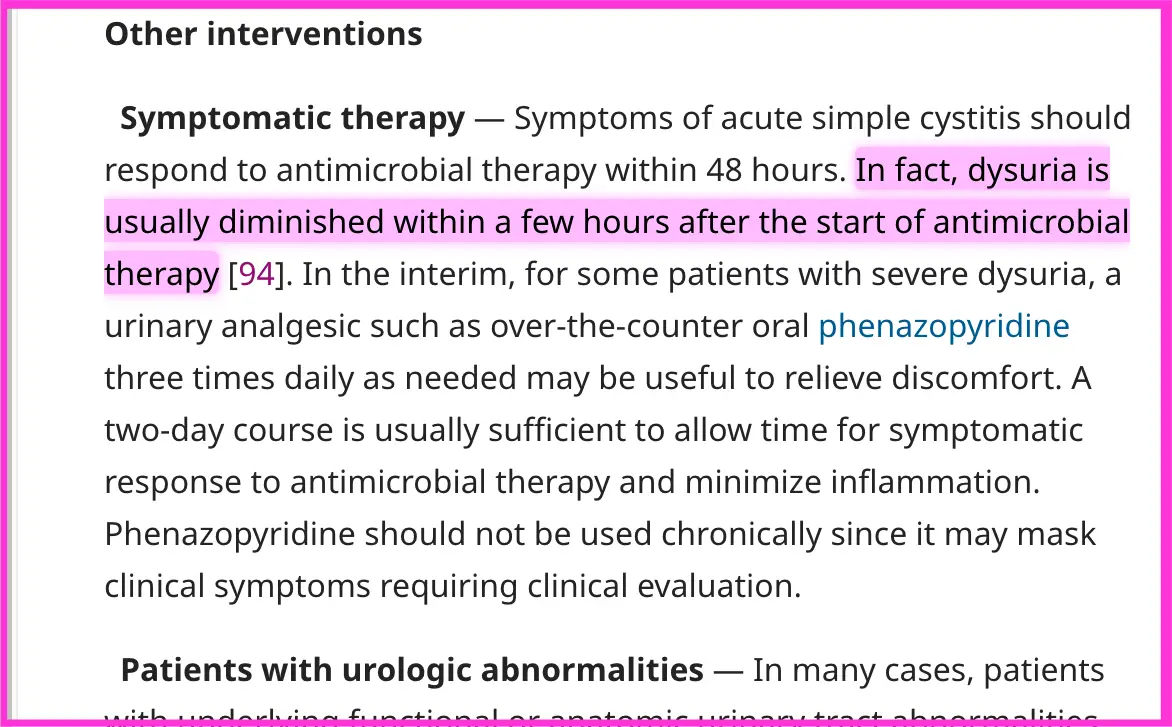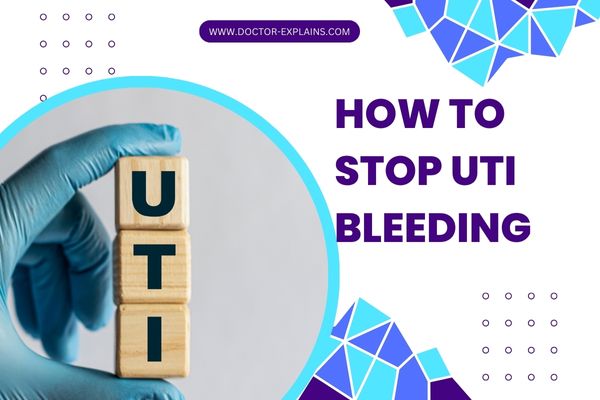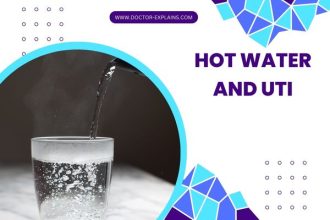How to Get Rid of UTI in 24 Hours
A short Answer:
The fastest and most effective way to get rid of UTI and its symptoms within 24 hours is to start the proper antibiotic and take strong analgesics. Other potentially effective remedies include peeing more often, heading pads, good hydration, and avoiding irritant foods and drinks.
Quick Insights:
- Early antibiotics produce quick UTI symptom relief within 24 hours in 87% of the patients.
- Use a urinary analgesic such as Phenazopyridine (Pyridium or AZO Urinary Pain Relief) to quickly control UTI pain.
- Ibuprofen or other NSAIDs are alternatives to phenazopyridine.
- Other Tips for fast relief of UTI symptoms:
- Peeing more often.
- Using a heating pad.
- Drink more fluids.
- Avoid irritant foods and drinks such as spicy foods.
- Wear loose-fitting clothes.
- Try comfortable sleeping positions.
[1] Start an antibiotic ASAP.
Antibiotics are the single most important treatment if you have an active UTI. Antibiotics not only eliminate the causative bacteria but also helps you get rid of UTI symptoms.
You will get rid of 90% of your UTI symptoms, such as dysuria, pain, and frequency, within 24 hours of starting the antibiotic (reference).

In one study, 50% of women with UTI experienced an improvement in UTI symptoms within 6 hours after starting the proper antibiotic.
Moreover, 87% of women in the study got rid of the UTI symptoms within 24 hours.
So, Working with your doctor to start the proper antibiotic is the best strategy if you want to get rid of UTI within 24 hours.
What antibiotics to take for UTI?
The best empirical antibiotics to take without waiting for the culture and sensitivity results are Nitrofurantoin (Macrobid®), Trimethoprim-Sulfamethoxazole (Septra®), or Fosphomycine.
Those are prescription medications; work with your GP or kidney doctor to determine the best antibiotic for you.
The doses and duration of the common antibiotics are illustrated in the table below.
| ANTIBIOTIC | DOSE | DURATION |
|---|---|---|
| Nitrofurantoin (Macrobid®) | 100 mg Tablets twice daily | 5 days. |
| Trimethoprim-Sulfamethaxazole(Septra®). | 160/800 mg Twice daily | 3 days |
| Fosfomycin (Monurol®) | 3 g oral tablets. | Single dose |
| Trimethoprim (for patients with Sulfa allergy) | 100 mg oral tablets twice daily | 3 days. |
| Pivmecillinam (Not available in USA). | 400 mg tablets three times daily | 3-5 days. |
Disclaimer: Early antibiotics are not for everyone.
The early use of antibiotics may not be suitable for everyone. Your doctor may decide to wait for the urine (culture and sensitivity) test results to determine the best antibiotics.
So, discuss the symptoms and options for treatment of your UTI to avoid unnecessary use of medications.
[2] Phenazopyridine.
Phenazopyridine is an analgesic (pain-relieving) medication that can help to reduce the discomfort of UTI symptoms such as pain, burning, and urgency.
If your UTI symptoms are severe, You can take Phenazopyridine tablets to help you get rid of UTI symptoms fast.
Notably, phenazopyridine is not an antibiotic and will not cure a UTI. It is only used to alleviate the symptoms.
Drug Summary and How to take:
To get rid of UTI pain, take 200 mg tablet with meals three times a day for up to two days.
| DRUG | Phenazopyridine. |
|---|---|
| BRAND NAME | AZO® Urinary Pain Relief, Pyridium® |
| AVAILABILITY | Available as an Over-The-Counter Medication. |
| INDICATION | Dysuria (burning urination) with UTI. |
| DOSE | Adult: 200 mg Tablets, three times a day. |
| DURATION | Up to two days. Don’t Take the drug form for more than two days without medical consultation. |
| HOW TO TAKE | With or after meals to minimize |
| CONTRAINDICATIONS | Severe Kidney impairment (high Serum Creatinine or dialysis) or Hypersensitivity to the drug. |
| SIDE EFFECTSRare: Pruritis, skin rash, headache, stomach upset, nausea, vomiting, red or orange urine, hypersensitivity reactions, anemia, kidney failure. |
[3] Ibuprofen (alternative to phenaozopyridine).
Ibuprofen is an over-the-counter medication that can relieve the pain and discomfort of UTI symptoms.
You can use Ibuprofen (Advil®) as an alternative to phenazopyridine (Pyridium®). Ibuprofen will help quickly relieve UTI symptoms such as burning urination, bladder pain, and fatigue.
The Available OTC dose for ibuprofen is 200 mg. You can take one to two tabs of ibuprofen 200 every 6 to 8 hours to alleviate UTI symptoms.
Don’t use ibuprofen if you have peptic ulcer disease, severe gastritis, or kidney impairment.
[4] Empty your bladder frequently.
Frequent urination helps to flush out the bacteria that cause UTIs. Urinating as soon as you feel the urge for partial relief of the UTI symptoms is important.
Frequent bladder emptying puts pressure on bacteria and prevents them from building up in the urinary tract. Frequent urination may also prevent worsening symptoms of UTI.
[5] Drink lots of water.
Drinking plenty of fluids is important to help flush out the bacteria that cause UTIs.
Make sure to drink at least 8 glasses of water daily (about 3 liters per day), or more if you can.
Water is the best choice, but you can also have other fluids such as herbal teas, juice, and soups.
Avoid caffeine, alcohol, and carbonated beverages, as these can irritate the bladder.
Although water may make you pee more frequently, It helps alleviate the burning urination by flushing the bladder and decreasing inflammation.
[6] Use a Heating pad.
Using a heating pad or hot water bottle on your lower abdomen can help to reduce the pain and discomfort of UTI symptoms.
Applying heat to the affected area can help to reduce inflammation, muscle spasms, and pain. Make sure to wrap the pad or bottle in a towel to avoid burning your skin.
[7] Avoid irritant drinks and foods.
Some foods and drinks may worsen bladder pain or increase urine frequency during a UTI. To quickly get rid of UTI, avoid these drinks for at least 24 to 48 hours:
- Coffee (even without caffeine) and other caffeinated drinks.
- Carbonated drinks.
- Tea
- Alcohol (especially carbonated alcoholic beverages).
- Acidic fruits include oranges, grapefruits, lemons, limes, and fruit juices.
- Spicy foods.
- Tomato-based products.
- Carbonated drinks.
- Chocolate.
[8] Don’t “compress” your irritated bladder.
Don’t hold your pee.
When you have a UTI, it is important not to “compress” your bladder. This means you should not delay urinating when you feel the urge to do so. Holding urine in your bladder will greatly increase UTI discomfort.
Try to empty your bladder frequently and drink plenty of fluids to help flush out bacteria.
Wear loose clothing.
Tight underwear or trousers may compress your urinary bladder and worsen UTI pain. Wear loose-fitting clots to avoid the compression of your bladder.
Try a comfortable sleeping position.
Some sleeping positions are more comfortable for your bladder than others. If you are not able to sleep with UTI pain, try lying on your side (right or left) in the fetal position (pulling your legs near your chest). This is the best sleeping position for a person with UTI.
BONUS: Cranberries and D-mannose are NOT effective for active UTIs.
Cranberries and D-mannose have been found to have beneficial effects when it comes to preventing Urinary Tract Infections (UTIs) from recurring.
However, if you are already suffering from a UTI or require symptom relief, these two substances will not help.
Therefore, while cranberries and D-mannose can help in preventing UTIs, they cannot be used as a treatment for UTIs or symptom relief.





